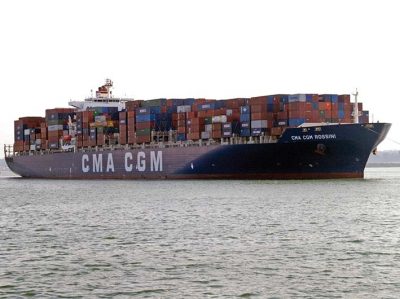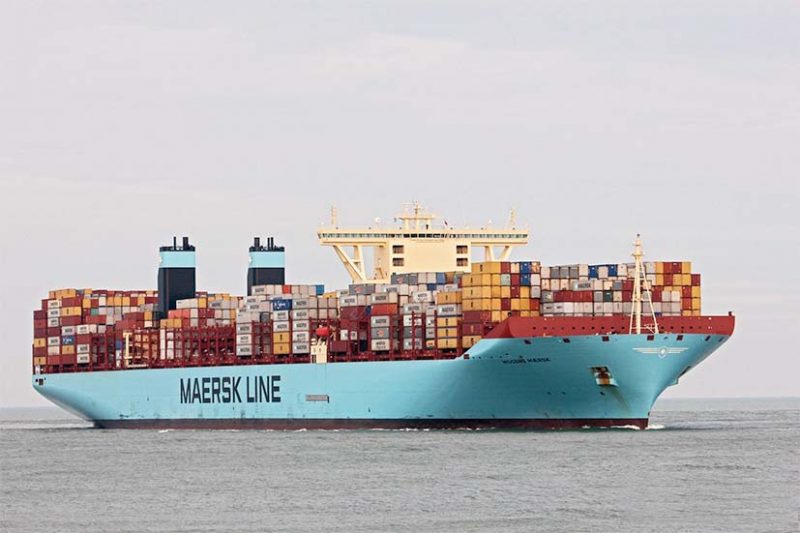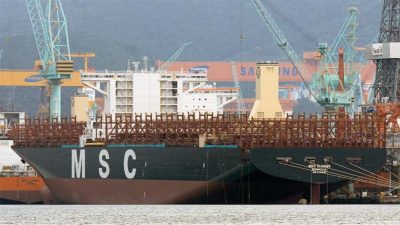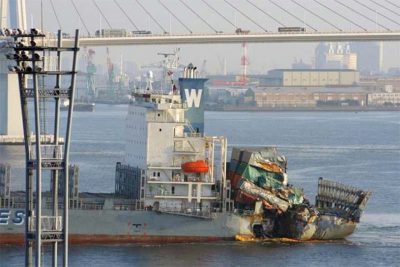APL announced the launch of the Atlantic Gulf Express (AGX) Service on 16th September, a direct Trans-Atlantic service which connects the key markets of North Europe, US South Atlantic and Gulf of Mexico. The new AGX service calls at Le Havre, Antwerp, Rotterdam, Bremerhaven, Charleston, Savannah, Miami, Veracruz, Altamira, Houston and New Orleans. The first sailing commenced from Le Havre on 2nd October 2016.
CMA CGM is outsourcing some of its global feeder operations in a move that rival carriers are likely to replicate as all attempt to reduce costs. CMA CGM has reduced its 600-1,750 TEU capacity feeder ships from 171 to 133 as it transfers certain feeder services to third-party operators. The reported recent surge in available tonnage in the 1,000 to 1,250 TEU range is largely due to CMA CGM, which has redelivered 13 ships in this capacity range recently. The main beneficiaries of the outsourcing have included specialist feeder lines such as X-Press Feeders, Unifeeder, and Unimed Feeder Services, which are chartering ships to handle CMA CGM’s cargoes. CMA CGM’s change in strategy indicates a major policy shift as it has been growing its feeder fleet and acquired OPDR, a German short-sea carrier, as recently as June 2015. Feeder services have become more important with the arrival of the mega-ships that have until recently been deployed primarily on the Asia- Europe trade.
European short-sea operators of the CMA CGM group (MacAndrews & OPDR) are expanding their container capacity with 4,000 new pallet wide dry containers. The 40-foot high cube containers can hold five additional euro-pallets compared with standard 40-foot units and are also more secure. They are 11.8 inches higher than standard containers and also have a higher payload, allowing for the shipping of heavier goods. The containers are more secure than standard units because their larger dimensions allow for more precise positioning of pallets, reducing the space between them. This means there is less room for cargo to shift around the container while it is in transit. CMA CGM has amended the port rotation of the EURAF 3 and WAZZAN services which connect Europe to West Africa. As of 23rd September 2016, EURAF 3, operated with three vessels of 1,800 TEU capacity, added a weekly direct call at Banjul (Gambia) in its rotation. The 17,518gt/2007 built Cala Paguro was scheduled to depart Tangiers (Morocco) on 23rd September with an estimated time of arrival in Banjul of 8th October. The new port coverage of the EURAF 3 includes the ports of Tangiers (Morocco), Algeciras (Spain), Freetown (Sierra Leone), Conakry (Guinea), Monrovia (Liberia), Banjul (Gambia) and Tangiers. The existing Banjul call on the WAZZAN service was discontinued as from the 11,062gt/1994 built Delmas Swala’s voyage, starting her rotation in Casablanca, with an estimated departure on 25th September. In addition, a service improvement to the WAZZAN service includes a direct Southbound call at Las Palmas (Spain), effective 13th October 2016. The new port coverage of the WAZZAN service is as follows: Casablanca (Morocco), Algeciras (Spain), Tangiers (Morocco) (connection Worldwide/ECSA), Las Palmas Southbound (Spain), Nouakchott (Mauritania), Dakar (Senegal), Nouadhibou (Mauritania), Casablanca.
DP World London Gateway Port has won a new service to Australia, South Asia and the Mediterranean in the form of CMA-CGM’s NEMO (North European Mediterranean Oceania) and Hapag Lloyd’s EAX (Europe, Australia Express) combined service that will begin calling at DP World London Gateway Port in early January 2017, with the 65,730gt/2004 built CMA CGM Rossini (above) the first to call on the service. The new business will mean DP World London Gateway is handling all of the UK’s direct services to Australia.
Evergreen Line has joined forces with China’s COSCO in operating a joint Adriatic– Israel (AIS) Service. The parties said that the new initiative opens up the corridor between North Adriatic ports, Piraeus and Israel, and provide direct and speedy service to customers. Two ships of around 1,000 TEU capacity will be deployed on the new weekly service, one each operated by the joint service partners. The first sailing on the AIS Service started from Koper on 4th October with the following port rotation: Koper (Slovenia)-Ravenna (Italy)-Venice (Italy)- Piraeus (Greece)-Haifa (Israel)-Ashdod (Israel)-Koper (Slovenia).
Hammonia Reederei of Hamburg has joined the growing trend to scrap exceptionally young containerships after selling the 35,824gt/1993 built and 3,100 TEU capacity Westphalia to Bangladesh for scrap. With the opening of the expanded new Panama Canal, Panamax rates have plummeted and so Panamax containerships have been scrapped in very high numbers in 2016 with 150,863 TEU of capacity disposed of during the period of January to June, equal to the volume of the previous 18 months through to December 2015. Hammonia Reederei is a joint venture between three partners: Peter Döhle, HCI and Ardian. Hammonia Reederei has a fleet of around 50 containerships ranging in size from 868 TEU to 10,000 TEU plus ten other ships. Following these disposals, a ship of just 10 years in age was disposed of for scrapping. The 52,701gt/2006 built and 4,546 TEU capacity Viktoria Wulff was owned by Erste RHW Schiffahrts.
Hansa Treuhand of Hamburg has become another victim of the container and has sought court protection for a number of its ships. The company expects to halve its fleet of around 50 ships and sought immediate creditor protection for 15 container ships at a court in Hamburg.
Hapag-Lloyd is investing in its container fleet this year having ordered a total of 5,750 refrigerated containers (reefers) of the latest generation, including 5,000 40-foot and 750 20-foot units. In addition, 1,000 of the new containers are equipped with controlled atmosphere technology, which allows various types of fruits and vegetables to be transported for longer periods of time while maintaining a consistent quality. Hapag- Lloyd also transports other high-value products in reefer containers, such as pharmaceuticals. The new containers were delivered from October and accompanies the pending delivery of the first of five new 10,500 TEU vessels of the Valparaíso Express Class being built in South Korea. These 2,100 TEU reefer capacity ships are scheduled to go to sea between South America and Europe beginning in late 2016.
Kawasaki Kisen Kaisha (K Line) dismissed reports from China in September that the company will shortly follow Hanjin Shipping into administration. Reports later suggested that the false news originated from Singapore’s APL Logistics (APLL) with legal measures then being considered against the source of the rumours. K Line posted a $266 million quarterly net loss with its containership segment accounting for $121.9 million of that with revenues falling 27.1% year on year. The contentious APL Logistics emails stating a potential bankruptcy of K Line were circulated by APL Logistics (not to be confused with the container line APL) to their customers on 20th September. No smoke without fire? Only time will tell. APL Logistics was purchased by Japanese forwarder Kintetsu World Express early in 2015 for $1.2 billion.
Maersk Line brought one of the 20,000 TEU capacity Triple-E ships to Colombo on 23rd September. Maersk intends to use Colombo as a transhipment hub for cargo destined to and from South and Eastern India and Bangladesh. The 194,849gt/2014 built Mogens Maersk (above) made the first call on 23rd September whilst serving the AE2 service, under the global 2M alliance between Maersk Line and MSC connecting Asia and Europe. As expected A.P. Møller- Mærsk announced in September that it will divide its energy and transport divisions in perhaps the greatest shake up in its more than 100-year history. The oil and oil related businesses in A.P. Møller-Mærsk A/S will require different solutions for future development including separation of entities individually or in combination from A.P. Møller- Mærsk A/S. The Transport & Logistics sector will consist of Maersk Line, APM Terminals, Damco, Svitzer and Maersk Container Industry based on a one company structure with multiple brands. The Energy sector will consist of Maersk Oil, Maersk Drilling, Maersk Supply Service and Maersk Tankers. Additional investments in the group’s offshore service businesses and Maersk Tankers will be limited. Maersk has also announced that it plans to halt newbuild orders in favour of takeovers in an industry that has been plagued by overcapacity for almost a decade. The company still has 27 ships on order, around 12% of its current fleet. Maersk Line has also been linked to possible takeovers of Hanjin Shipping and Hyundai Merchant Marine but this could just be conjecture as rumours were rife within the industry in the wake of Hanjin’s demise. The 92,198gt/1999 built Aotea Maersk has become the largest container ship to visit New Zealand when she called at the Port of Tauranga. The 9,500 TEU capacity vessel was the first call in a revised Triple Star service from Asia announced in July.

Matson’s order for two new LNG-powered container and roll-on/roll-off vessels placed at NASSCO in August will generate $120 million for South Korea’s Daewoo Shipbuilding & Marine Engineer (DSEC). The contract was signed between DSEC, a subsidiary of DSME, and General Dynamic’s NASSCO shipyard in San Diego, where the vessels will be built. The contract covers design and supply of materials. Matson’s new 265m long and 34.9m beam vessels, to be called the Kanaloa class, will be built on a 3,500 TEU platform, with enclosed garage space for up to 800 vehicles. The Kanaloa-class will be equipped with dual fuel engines capable of operating on either conventional fuel oils or LNG.
MPC Maritime Investments, a subsidiary of MPC Capital, has negotiated the sale of eight containerships for around $398 million. The buyer is an unnamed Asian finance syndicate which intends to continue to use the M-Star fleet ships for charter operations. Two of the eight vessels had been handed over to their new owners in September. The handover of the remaining six ships was scheduled to take place during October/November.
MSC and Maersk Line via their 2M alliance are adding capacity to the Far East-U.S west coast trade lane to fill the void left by Hanjin Shipping’s departure. The 2M partners will operate the first three sailings of their TP- 1/Maple service with vessels ranging in size from 7,800 to 9,400 TEU. Two of the journeys are reportedly one-way only, as the 9,400-TEU ships will join the U.S west coast to Mediterranean route after completing their transpacific eastbound voyages. Talks are ongoing for Hyundai’s container business to join the 2M. The new 193,000gt/19,500 TEU capacity MSC Eloane (above) was delivered at the end of September to Norwegian ship owner Ocean Yield from Samsung Heavy Industries in South Korea. The MSC Eloane has now commenced a 15-year bareboat charter.
MSC and Israeli shipowner Zim Integrated Shipping Services (ZIM) have decided to jointly offer a new Black Sea service. Scheduled to commence in November, the service will operate at the following rotation: Alexandria-Ashdod-Novorossiysk- Alexandria. The weekly service will feature two vessels that will operate on a fixed Ashdod Friday departure.
OOCL, a member of the G6 Alliance, planned to start implementing its Asia-North America East Coast Winter Program during October in response to seasonal changes in market demand. The service changes, which are subject to regulatory approval, include the suspension of the China East Coast Express 2 (CEC2) service from Week 45 and the new port of call on the company’s China East Coast Express (CEC) coverage. The last eastbound sailing on the CEC2 will be the 53,807gt/2005 built Bellavia, with an estimated time of arrival at Da Chan Bay, China, on 30th October 2016. CEC2 South China/Southeast Asia port coverage will be provided by OOCL’s current CEC service. CEC service will add a call at Da Chan Bay to enhance South China coverage with the enhanced service effective from Week 44 via the 93,750gt/2008 built Bremen Express, with an estimated time of arrival at Kaohsiung on 3rd November 2016.
Oldenburg-Portugiesische Dampfschiffs- Rhederei (OPDR), part of the CMA CGM Group, called at C. Steinweg Group’s Süd- West-Terminal at Hamburg for the first time on 11th October 2016. The vessel concerned was the 10,965gt/2007 built and 925 TEU capacity DP Legacy, which is deployed in the CISS service. The terminal, which offers more than 210,000m2 of operational area, has a 1,350m long quay which provides six berths.
Rickmers Maritime has reached a situation where, according to industry reports, it will not be able to pay $179.7 million of senior debt which is due in March 2017. Furthermore, due to adverse market conditions which affected the company’s financial performance, Rickmers Maritime has said that it will not be able to meet the on-going coupon and principal payments of $73.1 million due in May 2017. In September the company began asking investors to exchange their debt with SGD 28 million of new perpetual bonds to avoid liquidation and total loss on the notes. This would also allow continued coupon payments under the new securities. Rickmers Maritime recorded a net loss of $55.6 million in the second quarter of 2016, compared to a loss of $15.7 million in the same period of 2015. The company’s charter revenue during the period fell to $18 million from $28.5 million in the second quarter of 2015, mostly due to reduced charter rates and a lower vessel utilisation rate amid a worsening charter market. The overall financial restructuring concerning the $253 million is being undertaken to ward off liquidation but the plans were not welcomed by investors. Reports suggest that 30 bondholders had formed a steering committee, and planned to appoint a legal adviser to negotiate better terms with the trustee-manager. On 29th September more trouble struck the financially-embattled container ship operator when a group of retirees, businessmen and others who have each sunk $250,000 or more into the bonds issued by the trust are demanding to get their principal back in full, with interest, immediately. They are trying to do this by exercising a so-called ‘acceleration’ clause in the bond contract. Rickmers Maritime, which is a trust, has already said that it will not be able to pay $4.2 million in coupons due November 2016, unless note holders agreed to lose more of their principal. More than 50 note holders who together hold $26 million of Rickmers notes have signed an acceleration notice, delivered to trustee DB International Trust. Only time will tell as to whether or not Rickmers Maritime is destined to follow Hanjin Shipping.
TOTE Maritime was reportedly planning to continue its operations as planned despite warnings about Hurricane Matthew. A vessel belonging to TOTE Maritime was scheduled to depart Jacksonville, Florida, while another ship was set to sail from San Juan, Puerto Rico. The company was cited as saying that the operations on its Jacksonville to Puerto Rico route would not be disturbed, despite the forecasts that seas along the route could get as high as 40 feet. TOTE Maritime’s 36,751gt/2015 built vessel Isla Bella, which replaced the ill-fated containership El Faro after it disappeared on the route in October 2015 during a hurricane, was also scheduled to sail to Puerto Rico on 7th October when Hurricane Matthew was projected to be closest to Florida’s First Coast. This announcement came a year after the company’s roll on, roll off cargo ship El Faro sank off Bermuda on 1st October near the eye of Hurricane Joaquin, taking all 33 crewmembers with her. The El Faro had been en-route to San Juan from Jacksonville when she was disabled some 36 nautical miles northeast of the Bahamas after losing propulsion.
Wan Hai Lines’ 25,836gt/2002 built Wan Hai 307 (above) suffered a fire in containers carrying dangerous goods off Hong Kong. The fire ignited in the fore part of the main deck of the 2,200 TEU capacity vessel and the crew was unable to get control of the blaze. The ship anchored west of Lamma Island and firefighting tugs were sent to the scene with special equipment. All the crewmembers were evacuated and firefighters boarded the vessel. Once the fire was extinguished the authorities permitted the ship to berth at a quayside between Cheung Chau Island and Lamma Island to be offloaded.
Yang Ming Line’s YM Wind 153,500gt and 14,000 TEU capacity container vessel was caught in the strong winds produced by Super Typhoon Meranti on 14th September that left a path of destruction across much of southern Taiwan. One of the hardest hit areas was Kaohsiung City, where the storm toppled containers, cranes and caused a number of ships to break free at the local port. The YM Wind is under construction at CSBC Corporation for Seaspan with delivery due in 2017 and is the final unit of the nine 368m ‘Saver’ ships ordered from CBSC. Another casualty from Super Typhoon Meranti was the 42,323gt/1994 built Gang Tai Tai Zhou which grounded near Xiamen, China after dragging her anchor.








Comments
Sorry, comments are closed for this item